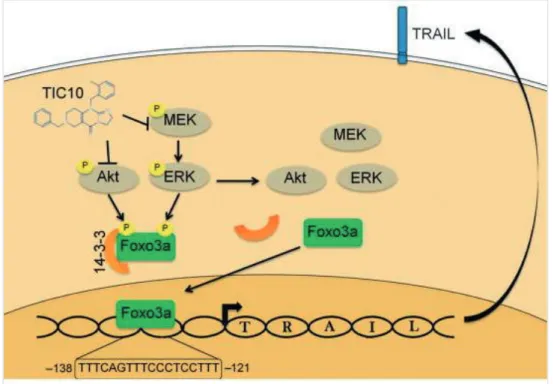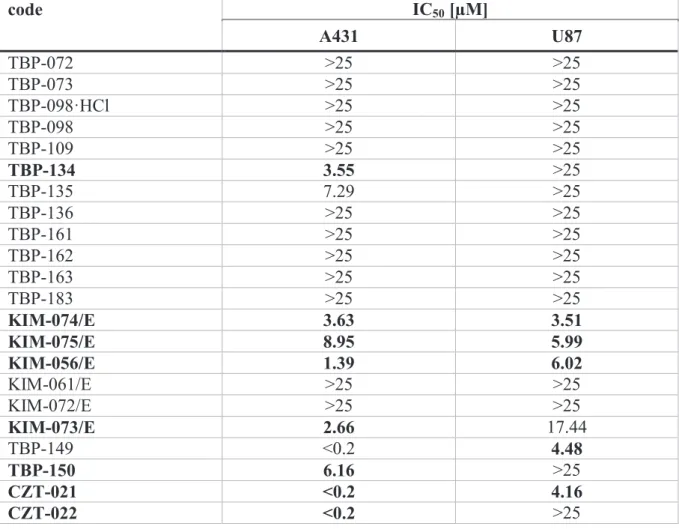DEVELOPMENT OF BIOCONJUGATES AND THEIR MODUL CONSTRUCTS FOR TARGETED THERAPY
OF CANCERS WITH HIGH MORTALITY
Excerption from the results obtained in frame of the grant NVKP_16-1-2016-0036
supported by the National Research, Development and Innovation Office
Budapest, 2020
DEVELOPMENT OF BIOCONJUGATES AND THEIR MODUL CONSTRUCTS FOR TARGETED THERAPY
OF CANCERS WITH HIGH MORTALITY
Excerption from the results obtained in frame of the grant NVKP_16-1-2016-0036
supported by the National Research, Development and Innovation Office
Budapest, 2020
ISBN 978-963-489-286-1
75
In vitro antitumor effect and structure–activity relationships of ferrocene- containing impiridone hybrids
Rita Oláh-Szabó1, Péter Bárány2, Imre Kovács2, Tamás Czuczi2, Szilvia Bősze1, Antal Csámpai2
1MTA-ELTE Research Group of Peptide Chemistry, Hungarian Academy of Sciences, Eötvös L. University, Budapest, Hungary
2Institute of Chemistry, Eötvös L. University, Budapest, Hungary
Introduction
ONC201 (TIC10, TRAIL-inducing compound 10) is an effective small molecular antitumor agent that is able to induce apoptosis in tumor cells (Figure 1).
The mechanism of action is based on activating TRAIL, tumor necrosis factor (TNF)-related apoptosis-inducing ligand. It was explored that TIC10 and its derivative, ONC212 inhibit Akt and Erk signaling, in this way induce translocation of the transcription factor Foxo3a into the nucleus (Figure 1 and Figure 2). The transcription factor Foxo3a enhance the TRAIL gene expression and stimulates TRAIL and death receptor-5 (DR5) transcription, finally activating TRAIL-mediated apoptosis pathway.1,2
Figure 1. Structure of ONC201 (TIC10) and ONC212
Apoptotic effect of ONC201 was demonstrated on hepatocellular carcinoma, including HepG2 cells,3 whereas ONC212 showed an anti-tumor effect via blocking Akt/Erk pathway in a glioblastoma cell line2 and its apoptosis induction was demonstrated on pancreatic tumor cell lines and xenografts as well.4
The organometallic ferrocene (bis(cyclopentadeinyl)iron) is also known as an antitumor agent; several ferrocene derivatives proved to be effective against HL-60 human leukemia cells5-7 and cisplatin-resistant ovarian cancer cells.8 Ferrocene can cause cell death via different mechanisms: e.g. via inhibition of COX-2 isoenzyme that is frequently
76
overexpressed in various tumor cells,9 but topoisomerase II inhibition of different ferrocene derivatives was also described.5
Figure 2. Mechanism of action of ONC201 and ONC212 initiating cell death
In these studies, we investigated antitumor effect of novel ONC201 hybrids with impiridone core and one or two differently positioned ferrocenylalkyl groups or halogenated benzyl groups on different human tumor cell lines, including melanoma, epithelial skin cancer, glioma, colon carcinoma and hepatocellular carcinoma.10
Results
Synthesis of the compounds was described in details by Bárány et al.10 Novel compounds were characterized by 1H- and 13C-NMR methods.
In vitro cytostatic effect of the compounds was measured by MTT assay11 on A2058 human melanoma, A431 human epithelial skin carcinoma, U87 human glioblastoma, HT-29 human colon carcinoma and HepG2 human hepatocellular carcinoma cell lines. Cells were treated with the compounds at 0.8-100 µM, 0.4-50 µM or 0.2-25 µM concentrations. Highest concentration for the treatment was determined with a preliminary solubility probe in serum free medium (RPMI-1640 or DMEM). Highest concentration for the treatment was determined with a preliminary solubility probe in serum-free medium (RPMI-1640 or DMEM). Cells were incubated with the compounds overnight, then the agents were removed and after several washing steps, cells were cultured for further 72 hours at 37 °C. The cytostatic effect was calculated with the following formula:
77
Cytostasis [%] = (1-Atreated/Acontrol)×100
IC50 values were calculated from sigmoidal curves fitted on the cytostasis data using Origin2018 software.
First, we tested a set of new compounds on A2058 human melanoma and HT-29 human colon carcinoma cell lines. We found 10 compounds that showed a moderate cytostatic effect (8.82 < IC50 < 69.43) including three ferrocene containing derivatives. Two compounds, however, proved to be markedly effective, the hydrochloride salt of 7-benzyl-4- (4-iodophenylmethyl)-2,4,6,7,8,9-hexahydroimidazo[1,2-a]pyrido[3,4-e]pyrimidin-5(1H)-one (NZS-009·HCl, IC50 = 2.7±1.1 µM on HT-29 colon carcinoma cells) (Table 1, Figure 3)
Figure 3. Chemical structure of the most effective compound, 7-benzyl-4-(4-iodophenylmethyl)-2,4,6,7,8,9-
hexahydroimidazo[1,2-a]pyrido[3,4-e]pyrimidin-5(1H)-one
The second group of compounds was tested on A431 human skin carcinoma and U87 glioblastoma cells (Table 2). Of these substances, several compounds showed significant anti-tumor effect and two compounds induced extraordinary activity on 431 cells (IC50 < 0.2 µM). For the most active compounds a patent application have been submitted.12
A third group of compounds was tested on four tumor cell lines, including the HepG2 human hepatocarcinoma cell line, A2058 human melanoma, A431 human skin carcinoma, and U87 human glioblastoma cells (Table 3). The results show that HepG2 cells were found to be much more sensitive to the compounds than the other cell lines, which is in consistence with the effect described for of ONC201.3 Among the highly cytostatic compounds we found azide, fluoro- and iodine-substituted derivatives as well as impiridone- gemcitabine hybrids (reference compound gemcitabine, CT-059G also showed a remarkable antitumor effect on three cell lines, except for U87 glioblastoma). Compound TBP-274 (7-(4- azidobenzyl)-4-(4-iodophenylmethyl)-2,4,6,7,8,9-hexahydroimidazo[1,2-a]pyrido[3,4-
e]pyrimidin-5(1H)-one) showed an outstanding effect on A2058 cells. (Table 3, Figure 4.).
78
Table 1. Cytostatic effect of impiridone hybrids on HT-29 human colon carcinoma and A2058 human melanoma cells
code HT-29 A2058
IC50 [µM] ±SD IC50 [µM] ±SD
NZS-009 B·HCl 16.9 8.6 5.28 0.86
NZS-009·HCl 2.7 1.1 8.82 7.14
TBP-038·HCl >100 - >100 -
TBP-039·HCl >100 - >100 -
TBP-040·HCl >100 - >100 -
KIM-011·HCl >100 - >100 -
TBP-052·HCl >100 - 47.365 23.50
TBP-053·HCl >100 - >100 -
TBP-054·HCl 33.0 23.3 20.91 12.46
TBP-055·HCl 34.0 21.9 17.64 6.65
NZS-009 B >100 - 27.57 33.88
NZS-009 >100 - >100 -
TBP-038 >100 - >100 -
TBP-039 58.6 18.6 >100 -
TBP-040 >100 - >100 -
KIM-011 >100 - >100 -
TBP-052 35.6 0.5 31.22 8.98
TBP-053 11.6 3.5 13.51 8.49
TBP-054 >100 - >100 -
TBP-055 >100 - >100 -
NZS-033 22.08 9.43 9.53 8.14
NZS-034 >100 - >100 -
NZS-036 >100 - >100 -
TBP-116 45.35 38.56 35.12 30.64
TBP-117 69.43 7.83 >100 -
TBP-118 14.33 7.81 14.16 8.05
TBP-125 40.16 5.32 28.73 11.92
TBP-126 >100 - 49.84 13.56
TBP-127 39.86 16.50 32.33 22.82
TBP-128 >100 - 57.23 20.24
TBP-129 40.87 2.37 28.12 13.31
TBP-130 >100 - 42.00 26.85
CZT-016 55.68 3.77 45.4 2.60
CZT-016·HCl 54.69 9.21 43.6 2.97
CZT-018 72.40 13.02 52.0 1.12
CZT-018·HCl 45.97 3.12 45.0 0.98
NZS-022 26.52 15.25 36.3 13.35
TBP-029 24.82 4.46 >100 -
NZS-033 22.1 9.4 9.5 8.1
NZS-034 >100 - >100 -
NZS-036 >100 - >100 -
79
Table 2. Cytostatic effect of impiridone hybrids on A431 human skin carcinoma and U87 human glioblastoma cells.
code IC50 [µM]
A431 U87
TBP-072 >25 >25
TBP-073 >25 >25
TBP-098·HCl >25 >25
TBP-098 >25 >25
TBP-109 >25 >25
TBP-134 3.55 >25
TBP-135 7.29 >25
TBP-136 >25 >25
TBP-161 >25 >25
TBP-162 >25 >25
TBP-163 >25 >25
TBP-183 >25 >25
KIM-074/E 3.63 3.51
KIM-075/E 8.95 5.99
KIM-056/E 1.39 6.02
KIM-061/E >25 >25
KIM-072/E >25 >25
KIM-073/E 2.66 17.44
TBP-149 <0.2 4.48
TBP-150 6.16 >25
CZT-021 <0.2 4.16
CZT-022 <0.2 >25
Table 3. Cytostatic effect of impiridone hybrids on HepG2 human hepatocarcinoma cell line, A2058 human melanoma, A431 human skin carcinoma, and U87 human glioblastoma cells.
Code IC50 [µM]
U87 A2058 A431 HepG2
TBP-272 6.1 1.25 11.1 <0.2
TBP-274 >25 0.7 >25 <0.2
CZT-054 >25 7.5 >25 0.6
CZT-059 >25 >25 >25 2.6
CZT-059G >25 <0.2 2.7 <0.2
CZT-061 >25 >25 >25 0.6
CZT-069 >25 >25 >25 0.7
CZT-091 >25 >25 8.26 3.8
CZT-092 >25 7.25 4.4 3.4
CZT-097 10.6 1.6 9.3 0.8
CZT-099 >25 4.65 >25 8.1
CZT-100 22.3 1.7 >25 0.9
CZT-102 >25 6.3 >25 4.0
80
Figure 4. Structure of TBP-274 (7-(4-azidobenzyl)-4-(4- iodophenylmethyl)-2,4,6,7,8,9-hexahydroimidazo[1,2-
a]pyrido[3,4-e]pyrimidin-5(1H)-one) References
1. Allen JE, Krigsfeld G, Mayes PA, Patel L, Dicker DT, Patel AS, Dolloff NG, Messaris E, Scata KA, Wang W, Zhou JY. Wu GS. El-Deiry WS. Sci Transl Med 5:171ra17 (2013)
2. Ishida C T, Zhang Y, Bianchetti E, Shu C, Nguyen TTT, Kleiner G, Sanchez-Quintero MJ, Quinzii CM, Westhoff MA, Karpel-Massler G, Prabhu VV, Allen JE, Siegelin MD. Clin Cancer Res 24: 5392-5406 (2018)
3. Cheng L, Liu YY, Lu PH, Peng Y, Yuan Q, Gu XS, Jin Y, Chen MB, Bai XM. Oncotarget 8:
28385-28394 (2017)
4. Lev A, Lulla AR, Wagner J, Ralff MD, Kiehl JB, Zhou Y, Benes CH, Prabhu VV, Oster W, Astsaturov I, Dicker DT, El-Deiry WS. Oncotarget 8: 81776-81793 (2017)
5. Vashisht Gopal YN, Jayaraju D, Kondapi AK. Arch Biochem Biophys 376: 229-235 (2000) 6. Zsoldos-Mády V, Csámpai A, Szabó R, Mészáros-Alapi E, Pásztor J, Hudecz F, Sohár P.
ChemMedChem 1: 1119-1125 (2006)
7. Miklán Zs, Szabó R, Zsoldos-Mády V, Reményi J, Bánóczi Z, Hudecz F. Biopolymers 88: 108- 114 (2007)
8. Pigeon P, Wang Y, Top S, Najlaoui F, Garcia Alvarez MC, Bignon J, McGlinchey MJ, Jaouen G.
J Med Chem 60: 8358-8368 (2017)
9. Farzaneh S, Zeinalzadeh E, Daraei B, Shahhosseini S, Zarghi A. Anticancer Agents Med Chem 18:
295-301. (2018)
10. Bárány P, Oláh-Szabó R, Kovács I, Czuczi T, Szabó CL, Takács A, Lajkó E, Láng O, Kőhidai L, Schlosser G, Bősze Sz, Mező G, Hucecz F, Csámpai A. Molecules 23: 2248 (2018)
11. Mosmann T. J Immunol Methods 65: 55-63 (1983) 12. Patent Application No. 1292889-3119/MOI (2019)





